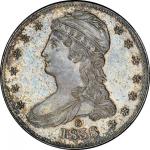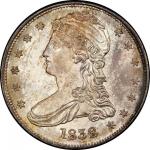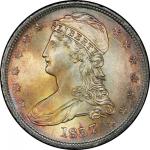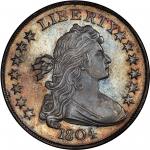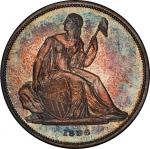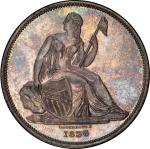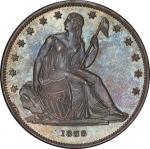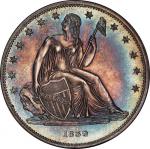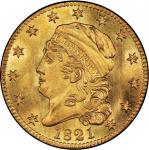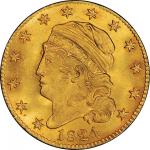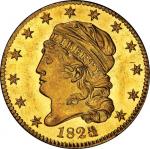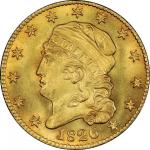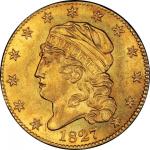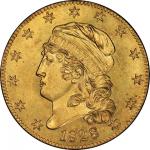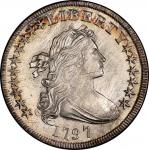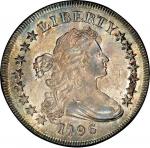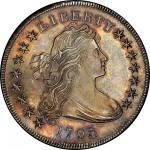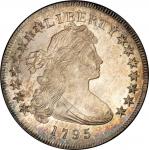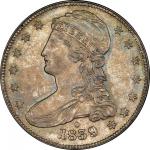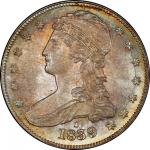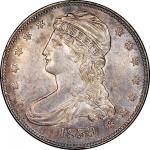This variety is rare and in good demand for type sets.” — Milferd H. Bolender, The United States Early Silver Dollars From 1794 to 1803, 1950</em>Attractively toned with golden amber, violet, and blue, this coin’s color scheme is somewhat reversed from the usual, with silvery brilliance around the peripheries and deeper color found in the fields. Sedate cartwheel luster remains on both sides, bolder on the reverse than obverse. The strike failed to impress full details at the centers, leaving some of the original planchet texture apparent, typical for the variety. Some fissures and inherent granularity are seen below Liberty’s ear and down the side of her neck, and the curls near the centering dot are flat. On the reverse, similar flatness is seen on the eagle’s breast and outstretched leg, and faint flecks on either side of the eagle suggest the original granularity of the silver planchet. The talon at right is particularly soft. The surfaces show good luster, with particularly bold cartwheel showcased on the reverse. Light hairlines are seen, but no heavy marks or other prominent flaws are noted. The only nick of consequence is hidden above the right loop of the bow at the base of the wreath.The die state is advanced, placing this among the last Small Eagle dollars ever struck. Evidence of a clash mark is best seen between the left side of the wreath and the adjacent eagle’s wing, along with a line from the obverse bust truncation seen above the eagle’s head. This clash, not described in the Bowers discussion of the die states of this variety, appears to have come from the marriage of this reverse with a 1797 obverse, a combination that interrupted the production of the early die state specimens of this 1798-dated variety from those, like this one, that were struck later. The obverse shows no cracks, though lapping has diminished the lowest curl left of the date and thinned the highest wave of hair beneath E of LIBERTY; this lapping likely took place before this obverse die was ever put into production. The reverse is in a worse state of disrepair, a situation exacerbated by the clashing it received. The most prominent die crack descends from the rim through the upright of the second T in STATES, crossing the wreath below. A nearly parallel but much thinner crack crosses the wreath left of the large crack, crossing the top of the nearby wing to the wreath left of the wing and down to the serif below the left upright of N in UNITED. A crack from the right base of I in UNITED follows the path of the wreath. Further cracks are seen from the midpoint of E, across the base of D and the midpoints of ST to the rim above; from above D to the rim above the first T of STATES; from above the second T of STATES through ES to the leaf atop the right side of the wreath; and along a long arc that begins in the denticles above ES, through the tops of OF and through the midpoints of all letters in AMERICA. Other light cracks are seen among the leaves below UN of UNITED. This is equivalent to Bowers Die State III, the terminal state of this combination, though that description incorrectly indicates that the cracks from N and I of UNITED connect. This high grade specimen shows conclusively that they do not, underscoring the importance of studying coins of this quality to fully understand die states and emission sequences, when possible.The Small Eagle reverse type saw its last use in 1798, where the design was employed on just two varieties. The 15 Star, Small Eagle variety combines two leftover dies. Its anachronistic obverse had been made before mid-1796 but left dateless, while its veteran reverse was first used on 1795 BB-51. The reverse used on the 13 Star, Small Eagle variety, as offered here, was also used to create 1797 BB-73, while its obverse was later married to a Heraldic Eagle reverse to create 1798 BB-91. As a major variety represented by a lone die combination, the 1798 13 Stars, Small Eagle has been in high demand among dollar collectors since before M.H. Bolender wrote his reference in 1950, though surprisingly few examples have survived in high grade. Just a single example of this variety, the MS-63 Cleneay-Green-Newman coin, has ever been graded finer by PCGS.PCGS# 6867. NGC ID: 24X5.


